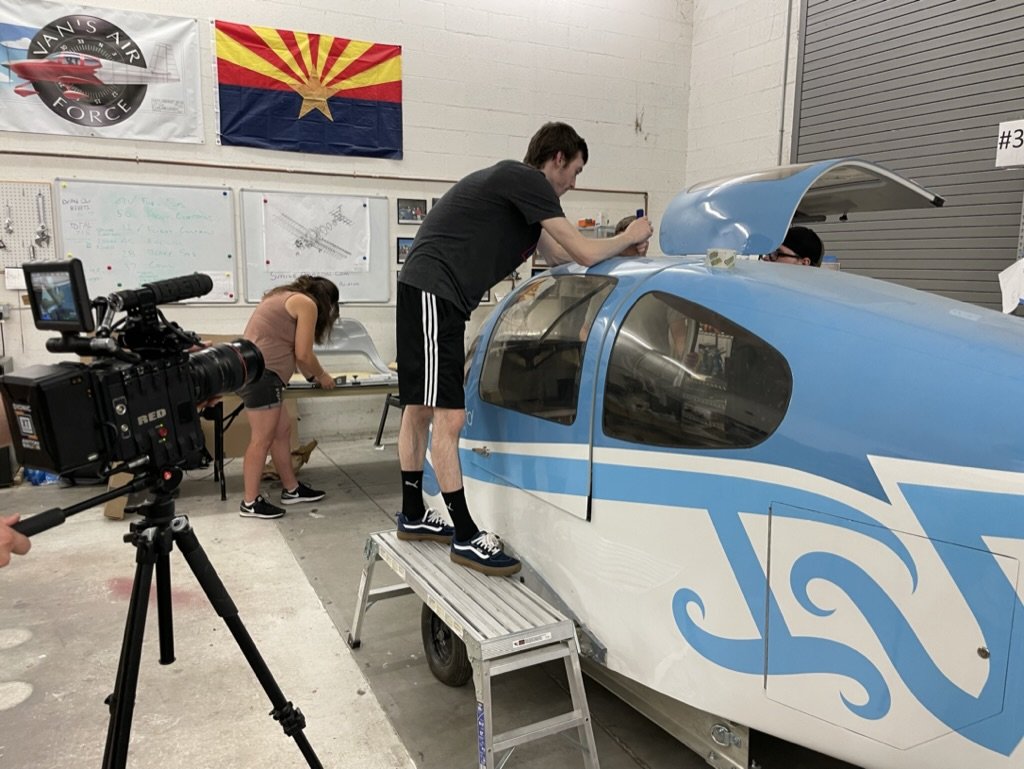How to open the door?
The students from Oregon Tech show the new door they installed on The Impossible Airplane Simulator. From left to right: Race Ross, Jake Baker, Amber Conord, Chewie (dog), Patrick Chamberlain, Jessica Cox, Ronald Collins, and Chase Ahrens.
Gull wing doors on a low wing airplane
One of the first things we realized needed to be changed (after the flight controls) was the door system on The Impossible Airplane. The Ercoupe makes it easy for Jessica to climb into. The windows on the bubble canopy slide down into the fuselage, so all she has to do is walk up with wing walk and step into the cockpit. The stock RV-10 doors make the situation a little different.
Like the Ercoupe, an RV-10 is a low wing airplane. Jessica can access the door by simply walking on the wing walk. The catch is that the door then swings out and up. There’s nowhere for Jessica to go except out onto the wing itself. Jessica is petite, but the wing isn’t designed for that.
So, The Impossible Airplane needed a solution to let Jessica open the door without standing on the wingwalk. In the summer of 2022, Ronald Collins was a machinist at Van’s Aircraft while studying at Oregon Tech to earn a degree as a mechanical engineer. He learned of the challenges we faced with various aspects of The Impossible Airplane. Ronald assembled a team of other students who needed a final project for their degree, and they began working on a new door solution.
The Oregon Tech team replaced the original door on our Impossible Airplane simulator and mounted their modified door.
After two semesters of work, the Oregon Tech team built an electric, automatic door system to open the door for Jessica. Two buttons operated the door. One was mounted in the baggage door rear of the wing on the left side of the fuselage, and the other button was mounted (for now) on the center tunnel between the pilot and copilot seats. A computer managed the signals and was also mounted on the inside of the baggage door.
The computer then controlled two linear actuators. When opening the door, the first linear actuator to move was inside the door, which unlatched the pins holding the bottom of the door in the door frame. Once unlatched, the other linear actuator at the top of the door activated to open the door (it was mounted where the standard gas strut was mounted). To close the door, the whole system operated in reverse.
This system was also programmed to operate if power was turned off while the door was open or mid-process. However, due to the design of the linear actuators, the door could not be operated manually. Actuators that would allow manual operation exist, but the team could not find ones small enough to fit into the required space and length. Unfortunately, that meant the door would not operate if the power were shut off or disconnected in an accident. There would also be no way for rescuers to operate the door from the outside.
These safety issues made us want to continue to refine the design. That being said, these students (now engineers, so send us an email if you’re hiring engineers, and we’ll connect you with them) ironed out many of the design elements we will need in the final system. They figured out the foundation we can continue to work on. They were mindful of safety concerns and mitigated them whenever possible. A safety shutoff switch was included to prevent accidental activation, for example. They also retooled the ends of the latches in the door to ensure the system locked properly.
We can’t make progress without people like Race, Jake, Amber, Ronald, and Chase. We hope their careers reflect their dedication and insight into inclusive designs they learned while working on this project.
EAA was generous in giving Rightfooted Foundation a sizable space for showing off the progress on The Impossible Airplane.
This blog was a long time coming. We showed off their work at AirVenture 2023, and most of the team was there to help us manage our booth. If you want to know more and see the door in action, you can check out Jessica’s article with Flying Magazine. You can also leave us a comment, and we will try to answer it in a future post.
Thank you for your support!




